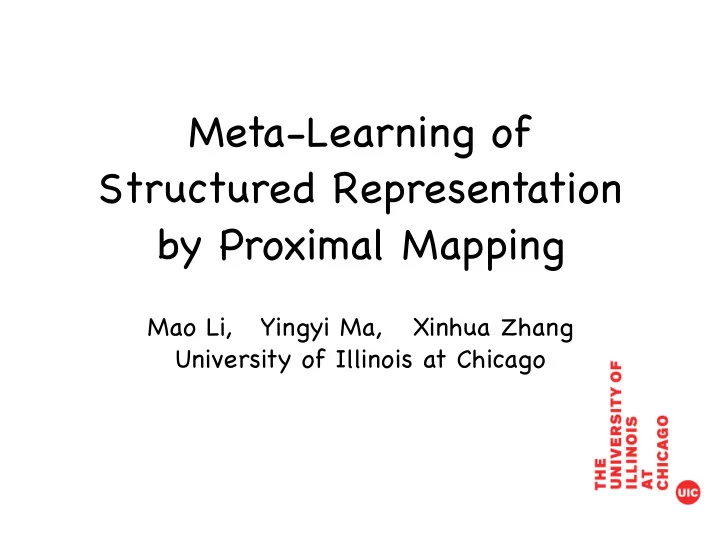

Meta-Learning of Structured Representation by Proximal Mapping Mao Li, Yingyi Ma, Xinhua Zhang University of Illinois at Chicago
Motivation Goal of meta-learning: Extract prior structures from a set of tasks that allows efficient learning of new tasks . Examples of structural regularities: • Instance level - Input layers: transformation beyond group-based diffeomorphism - Within layers: sparsity, disentanglement, spatial invariance, structured gradient accounting for data covariance, manifold smoothness - Between layers: equvariance, contractivity, robustness under dropout and adversarial perturbations of preceding nodes • Batch/Dataset level - multi-view, multi-modality, multi-domain - diversity, fairness, privacy, causal structure
Existing Approaches • Data Augmentation training data original data augmented data √ boost prediction performance × unclear the improvement is due to the learned representation or due to a better classifier.
Existing Approaches • Auto-encoder downstream encoder decoder label Tasks Input Reconstruction latent representation √ learned the most salient features × usually used as an initialization for subsequent supervised task × not amendable to end-to-end learning Our goal : learn representations that explicitly encode structural priors in an end-to-end fashion.
Existing Approaches • Regularization √ simple and efficient × contention of weights between regularizer and supervised performance
Proposed Method Morph a representation z towards a structured one by proximal mapping: promote desired structure z: mini-batch or single-example a mini-batch a task in meta-learning proximal mapping task-specific base learner Embed the proximal mapping as a layer into deep networks Advantages + decoupling the regularization and supervised learning + extend meta-learning to unsupervised base learners
Proposed Method Morph a representation z towards a structured one by proximal mapping: promote desired structure Before After L : graph-Laplacian (for smoothness on manifold)
MetaProx for Multi-view Learning In multiview learning, observations are available as pairs of views: {x i , y i }. feature extractor f view x supervised predictor h proximal layer view x label features f view x view x view y label features g view y view y proximal map view y supervised predictor h feature extractor g Figure 1: training framework of MetaProx
MetaProx for Multi-view Learning feature extractor f view x supervised predictor h ① proximal layer view x label features f view x view x view y label features g view y view y proximal map view y feature extractor g supervised predictor h ① feature extraction:
MetaProx for Multi-view Learning feature extractor f view x supervised predictor h ② proximal layer view x label features f view x view x view y label features g view y view y proximal map view y feature extractor g supervised predictor h ② proximal mapping: promote high correlation between two views
MetaProx for Multi-view Learning feature extractor f supervised predictor h view x ③ proximal layer view x label features f view x view x view y label features g view y view y proximal map view y supervised predictor h feature extractor g ③ supervised task h : supervised predictor
MetaProx for Multi-view Learning feature extractor f supervised predictor h view x ③ proximal layer view x label features f view x view x view y label features g view y view y proximal map view y supervised predictor h feature extractor g ③ supervised task optimize over red variables
Experiment Results Multi-view image classification - Dataset : a subset of Sketchy (20 classes) { ; … …; } ( , ), ’butterfly’ ( , ), ’cat’ Test accuracy for image classification
Experiment Results (English, German) Crosslingual word embedding word 1 - Dataset : WS353, SimLex999 word 2 . . - Metric : Spearman’ . . s correlation . . word n between the rankings by model and human Table 1: Spearman’ s correlation for word similarities
At the poster: More details and discussions Thanks! “Efficient Meta Learning via Minibatch Proximal Update” (NeurIPS 2019) MetaProx ≠ “Meta-Learning with Implicit Gradients” (NeurIPS 2019) modeling optimization
Recommend
More recommend